 Mottainai
Mottainai is said in Japan when something perfectly usable is abandoned or sent to the
trashcan. In the past ten years, Japan has seen a trend in awareness regarding waste and reusing whenever possible. It's ironic that this has become a trend because the idea of reuse goes way back and is intrinsic to Japanese cooking, for example using ALL parts of chicken for yakitori and
niban-dashi (drawing out stock from a source for the second time).
Mottainai is uttered in situations when one might see half a plateful of tortilla chips thrown away because there was too much served in the first place--or when you badly stain a piece of clothing and have to give up on it. "What a waste!
Mottainai!"
The Japanese have gladly embraced capitalism, disposable goods and plastic packaging. When coupled with the country's obsession of perfect and excessive wrapping (stemming from the
furoshiki tradition), disposable waste has led the Japanese to perfect the process of incinerating products deemed combustible (
moeru-gomi). Part of this process is categorizing trash into
such minute detail, that one needs to study and memorize a chart before disposing their trash properly.
Why all this talk about
mottainai? That's because this weeks' recipe is so anti-
mottainai. No waste on Japanify!
Tsukudani is a rice condiment that is made by simmering "once-used" food products (most often left behind from the
dashi-making process) in a mixture of soy sauce, mirin, sake and sugar. The advantage of
tsukudani is that it keeps very well, made very easily and quickly flavors a simple bowl of rice.
INGREDIENTS
200g (approx. 3 cups) fish shavings that have been used for extracting dashi (dried bonito or other fish flakes) or once-used kombu, brought back to room temperature. I used sanma shavings here.
8 tbsp shoyu (soy sauce)
4 tbsp
mirin
4 tbsp sake
2 tbsp sugar
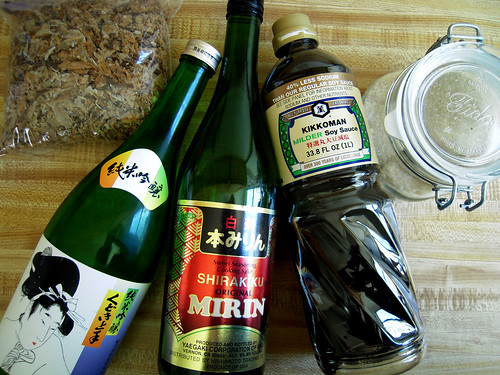 METHOD
METHOD
1. If possible, use a cast iron pot like a Le Creuset to avoid burning. Put fish shavings in the pot.
2. Mix together all the liquids and sugar in a bowl until the sugar dissolves.
3. Dump the liquid mixture into the pot.
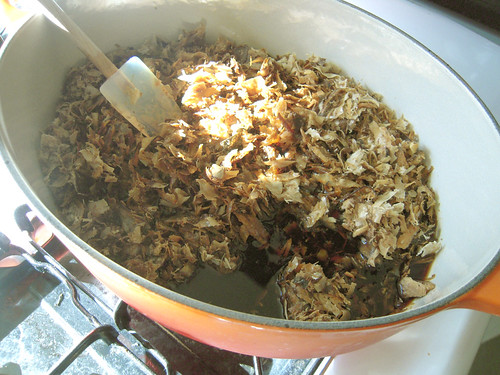
4. Keep over medium or medium-low, uncovered, for 40-60 minutes or until the liquid feels and looks syrupy when you rake a spatula across the bottom of the pot.
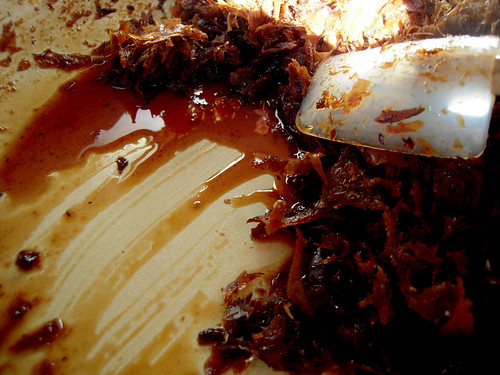
5. Taste the
tsukudani and add mirin or soy sauce if it's lacking sweetness or saltiness, respectively.
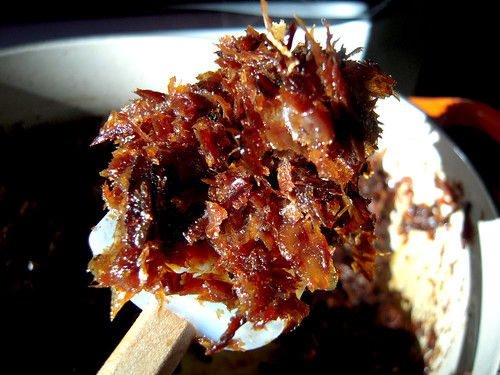
I made two types 1) plain and 2) with roasted sesame seeds mixed in, for a variation in flavor and texture.
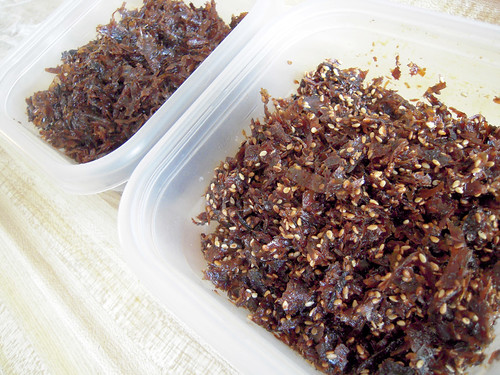
Knowing that my breakfast comes from a tradition of reuse is what gets me up and ready for a totally un-
mottainai day.

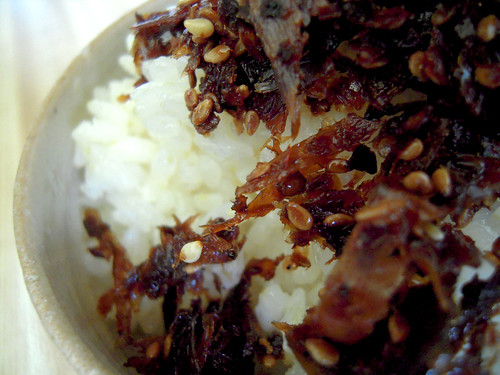
For folks who have never tried
tsukudani, I recommend that you try the store-bought version (in the refrigerated section of any Japanese market) before making it at home. As with any kind of food, it's better to know what you are striving for before you embark on a new cooking adventure.
*Every Thursday, Japanify aims to make Japanese cooking at home easy, accessible and affordable. For questions, please email Yoko directly at yoko@umamimart.com or simply comment below!
 Mottainai is said in Japan when something perfectly usable is abandoned or sent to the trashcan. In the past ten years, Japan has seen a trend in awareness regarding waste and reusing whenever possible. It's ironic that this has become a trend because the idea of reuse goes way back and is intrinsic to Japanese cooking, for example using ALL parts of chicken for yakitori and niban-dashi (drawing out stock from a source for the second time).
Mottainai is uttered in situations when one might see half a plateful of tortilla chips thrown away because there was too much served in the first place--or when you badly stain a piece of clothing and have to give up on it. "What a waste! Mottainai!"
The Japanese have gladly embraced capitalism, disposable goods and plastic packaging. When coupled with the country's obsession of perfect and excessive wrapping (stemming from the furoshiki tradition), disposable waste has led the Japanese to perfect the process of incinerating products deemed combustible (moeru-gomi). Part of this process is categorizing trash into such minute detail, that one needs to study and memorize a chart before disposing their trash properly.
Why all this talk about mottainai? That's because this weeks' recipe is so anti-mottainai. No waste on Japanify!
Tsukudani is a rice condiment that is made by simmering "once-used" food products (most often left behind from the dashi-making process) in a mixture of soy sauce, mirin, sake and sugar. The advantage of tsukudani is that it keeps very well, made very easily and quickly flavors a simple bowl of rice.
INGREDIENTS
200g (approx. 3 cups) fish shavings that have been used for extracting dashi (dried bonito or other fish flakes) or once-used kombu, brought back to room temperature. I used sanma shavings here.
8 tbsp shoyu (soy sauce)
4 tbsp mirin
4 tbsp sake
2 tbsp sugar
Mottainai is said in Japan when something perfectly usable is abandoned or sent to the trashcan. In the past ten years, Japan has seen a trend in awareness regarding waste and reusing whenever possible. It's ironic that this has become a trend because the idea of reuse goes way back and is intrinsic to Japanese cooking, for example using ALL parts of chicken for yakitori and niban-dashi (drawing out stock from a source for the second time).
Mottainai is uttered in situations when one might see half a plateful of tortilla chips thrown away because there was too much served in the first place--or when you badly stain a piece of clothing and have to give up on it. "What a waste! Mottainai!"
The Japanese have gladly embraced capitalism, disposable goods and plastic packaging. When coupled with the country's obsession of perfect and excessive wrapping (stemming from the furoshiki tradition), disposable waste has led the Japanese to perfect the process of incinerating products deemed combustible (moeru-gomi). Part of this process is categorizing trash into such minute detail, that one needs to study and memorize a chart before disposing their trash properly.
Why all this talk about mottainai? That's because this weeks' recipe is so anti-mottainai. No waste on Japanify!
Tsukudani is a rice condiment that is made by simmering "once-used" food products (most often left behind from the dashi-making process) in a mixture of soy sauce, mirin, sake and sugar. The advantage of tsukudani is that it keeps very well, made very easily and quickly flavors a simple bowl of rice.
INGREDIENTS
200g (approx. 3 cups) fish shavings that have been used for extracting dashi (dried bonito or other fish flakes) or once-used kombu, brought back to room temperature. I used sanma shavings here.
8 tbsp shoyu (soy sauce)
4 tbsp mirin
4 tbsp sake
2 tbsp sugar
 METHOD
1. If possible, use a cast iron pot like a Le Creuset to avoid burning. Put fish shavings in the pot.
2. Mix together all the liquids and sugar in a bowl until the sugar dissolves.
3. Dump the liquid mixture into the pot.
METHOD
1. If possible, use a cast iron pot like a Le Creuset to avoid burning. Put fish shavings in the pot.
2. Mix together all the liquids and sugar in a bowl until the sugar dissolves.
3. Dump the liquid mixture into the pot.
 4. Keep over medium or medium-low, uncovered, for 40-60 minutes or until the liquid feels and looks syrupy when you rake a spatula across the bottom of the pot.
4. Keep over medium or medium-low, uncovered, for 40-60 minutes or until the liquid feels and looks syrupy when you rake a spatula across the bottom of the pot.
 5. Taste the tsukudani and add mirin or soy sauce if it's lacking sweetness or saltiness, respectively.
5. Taste the tsukudani and add mirin or soy sauce if it's lacking sweetness or saltiness, respectively.
 I made two types 1) plain and 2) with roasted sesame seeds mixed in, for a variation in flavor and texture.
I made two types 1) plain and 2) with roasted sesame seeds mixed in, for a variation in flavor and texture.
 Knowing that my breakfast comes from a tradition of reuse is what gets me up and ready for a totally un-mottainai day.
Knowing that my breakfast comes from a tradition of reuse is what gets me up and ready for a totally un-mottainai day.

 For folks who have never tried tsukudani, I recommend that you try the store-bought version (in the refrigerated section of any Japanese market) before making it at home. As with any kind of food, it's better to know what you are striving for before you embark on a new cooking adventure.
*Every Thursday, Japanify aims to make Japanese cooking at home easy, accessible and affordable. For questions, please email Yoko directly at yoko@umamimart.com or simply comment below!
For folks who have never tried tsukudani, I recommend that you try the store-bought version (in the refrigerated section of any Japanese market) before making it at home. As with any kind of food, it's better to know what you are striving for before you embark on a new cooking adventure.
*Every Thursday, Japanify aims to make Japanese cooking at home easy, accessible and affordable. For questions, please email Yoko directly at yoko@umamimart.com or simply comment below!




Comments (10)
Nice post! Noticed the sake in the photo…wondered if you prefer using the Sudoki Jozu sake for cooking a lot or do you use different sakes for tasting vs. cooking? I am looking for a decent sake for cooking and don;t know if I should cook with a bottle that I would normally enjoy for tasting.
Having been a lucky recipient of Yoko’s tsukudani I can attest to its deliciousness. It is so luxurious compared to dried furikake sprinkles in a jar.
Hi Bobby,
Funny you noticed that because that sake is too could to be cooking with by regular standards… but that was the only sake I had in the house that day, having just a few swigs left in it. Normally, I won’t cook with something so fancy – I usually just use Takara’s Sho Chiku Bai Junmai. Just like cooking with wine, your food will reflect the quality of the alcohol – but if you aren’t super-sensitive it won’t matter too much. My husband gasped when he saw that I used Kudoki Juzo for this. In fact, he said “Mottainai!!” But I don’t think the Kudoki Juzo went unappreciated in the tsukudani. I firmly believe it made it more delicious.
Worm, I am so glad you enjoyed the flakes. I am pleased with the results and hope to create some more tsukudani concoctions – perhaps with small fish, clams and/or walnuts.
Bobby,
I’ll add that I will not cook with something that I find undrinkable – because again, this will be reflected in the food. I will usually cook with something that I find to have a satisfactory taste and an affordable price.
A trivia here. Did you know you can only buy real mirin at liquor stores in Japan? Also cooking sake has salt and other ingredients in it? It’s all about alcohol taxation issue. You can’t sell drinkable alcohol at supermarket, so they make cooking sake undrinkable. Also real mirin has about 14% alcohol, vs, mirin-fu has less. It’s sort of oxymoron since anyone can buy booze at vending machines in Japan.
I usually use cooking sake, which is totally fine, but when I went to Mitsuwa last time, I fancied up and bought sake in milk carton. They are still better than cooking sake. I would be careful when using real sake in cooking. Many sake has very distinct flavor, and adding it in your cooking may not be a good idea. When you do use real sake in cooking, make sure you choose something just crisp, not flavorful ones.
Thanks for the insight Yamahomo. I remember making the mistake of buying mirin-fu at a Japanese grocery store. I also thought it was odd when I moved back to California and they card me when I buy mirin! I guess it makes sense if it has 14% alcohol in it.
Skipped out on makanai tonight at work in anticipation for some ochazuke with Yoko’s tsukudani. Success! This stuff is awesome, especially the sesame seed version.
This is my midnight crack.
Thanks Yoko-gonna have to add some nice bottles of sake to my wine collection next time I go to my local Japanese grocery store. I’ll start by trying out that one if they have it. Love your blog-
Have a great weekend!
We love you, Bobby!
Love this, and love the great things I am learning from the comments!